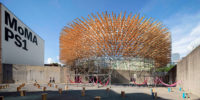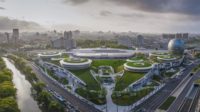New urban parks of all varieties are transforming neighborhoods around the country.
It's August, and if you're a city dweller, it's great to be able to hang out on a summer's day in a nearby park. But just how nearby depends on what city you live in. In June, the Trust for Public Land issued its ParkScore, a rating of park systems in America's 50 biggest cities. Minneapolis came out on top, based on three criteria: the percentage of residents who live within a 10-minute walk of a park (94 percent); the median size of its parks (6.5 acres), and the level of municipal investment. New York came in second, with even more people close to a park (96 percent) but with a smaller median size (only 1.06 acres).

Parks, not surprisingly, make people happy. A long-term study of 12,000 Britons by researchers at the University of Exeter found that those who lived in areas with green space expressed more satisfaction and were less distressed than those who didn't.
As the population grows in urban cores, parks have become more essential than ever. And the design profession is responding by creating ever more varied and unusual public spaces–the High Line in New York, Millennium Park in Chicago, the Olympic Sculpture Park in Seattle among them. The best parks cater not only to a wide range of citizens and activities but quietly foster sustainability by harboring wildlife and reducing potential damage from flooding and other disasters linked to climate change.
In eras past, civic parks were intended as pastoral escapes. But as early as 1939, in ARCHITECTURAL RECORD, three modern masters of landscape architecture–Garrett Eckbo, Daniel U. Kiley, and James C. Rose–wrote a futurist manifesto, “Landscape Design in the Urban Environment,” in which they advanced the following principles: “Design in the recreational environment of tomorrow must (1) integrate landscape and building, (2) be flexible, (3) be multi-utile, (4) exploit mechanization, (5) be social, not individual, in its approach.”
They were ahead of their time. “Until the 1960s, the profession was basically anti-urban,” recalls M. Paul Friedberg, the landscape architect of such breakthrough public spaces as Peavey Plaza (1975) in Minneapolis, recently listed on the National Register of Historic Places (and threatened with demolition). “I wasn't considered a landscape architect early in my career because I was working in hardscape.”
Today's urban parks, too, reflect and embrace the complexities of the contemporary city, often by regenerating leftover spaces. In this issue, we look at new landscape projects in six cities. Three of the projects dramatically subvert the culture of the car. In Dallas, the 5-acre Klyde Warren Park, designed by the Office of James Burnett, is built over a freeway–and knits together two downtown neighborhoods that were torn apart decades ago by urban renewal and the highway's construction. In Toronto, PFS Studio went under an elevated roadway to transform a dank and derelict area into a surprisingly vibrant venue for skateboarding and shooting hoops. In Grand Park in Los Angeles, the design firm of Rios Clementi Hale Studios took up a neglected plaza and parking lot and created a rich collage of varied spaces for downtown office workers and residents alike. Like many cities now reconnecting to formerly industrial waterfronts, Green Bay, Wisconsin, hired the firm of Stoss Landscape Urbanism to transform a stretch of land along the Fox River. In Washington, D.C., the latest new public space in the vast development Capitol Riverfront is Canal Park, designed by OLIN (whose founding partner, Laurie Olin, was recently honored with the National Medal of Arts).
The smallest urban park in the pages ahead isn't a “found” space, but its history as a public place has been tortured. The Jacob K. Javits Federal Building Plaza in New York was the home of Richard Serra's sculpture Tilted Arc, until the 120-foot-long wall of Cor-Ten steel was finally removed following a roaring controversy in the 1980s over its impact on the site. For the plaza's current iteration, Michael Van Valkenburgh Associates has created an urbane space of pink granite and pale marble, softened by crescents of plantings. Like the other new landscapes in RECORD this month, it is a magnet for the people who work in the area.
And isn't that the point? Along with Eckbo, Kiley, and Rose, his modernist forebears, Friedberg believes the purpose of public landscapes is to be social, filled with human activity. “We're more interesting than what we build,” he maintains. “The spaces have to celebrate us, the people.”






Post a comment to this article
Report Abusive Comment